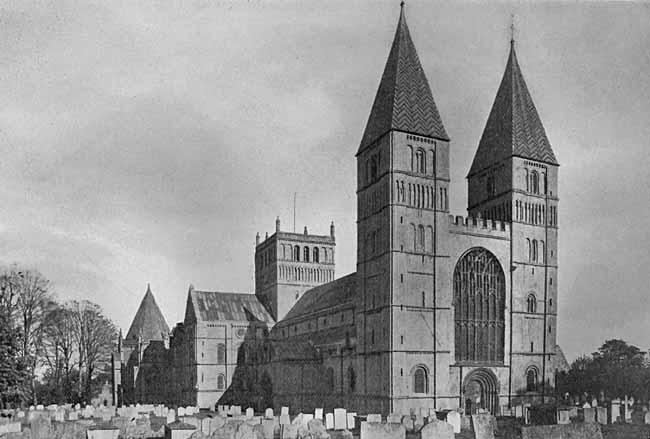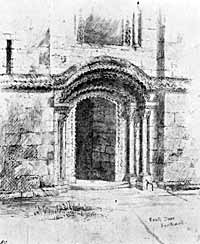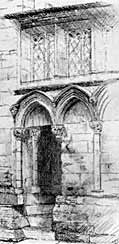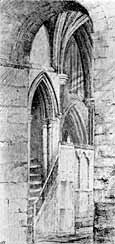On arrival at Southwell luncheon was served at the Saracen’s Hotel, and it was followed by the annual meeting, over which the Rev. T. W. Swann presided. The first item on the agenda was a vote of sympathy with the Duchess of St. Albans and her family in the great bereavement they had sustained by the death of the Duke, who was president of the Thoroton Society. The vote was carried unanimously.—On the motion of Mr. Phillimore, seconded by Mr. Radford, the Duke of Portland was elected president for the ensuing year. —Mr. J. C. Warren then presented his financial statement as treasurer of the association, which showed that on that day the society had over £70 in hand.—The vice-presidents were re-elected with the addition of Canon Trebeck and Dr. G. W. Marshall.—The council was then re-appointed, with the addition of Mr. P. J. Cropper and Mr. James Ward, and the other officers were re-elected.
 Southwell Minster.
Southwell Minster.The party attended evensong in the Minster at three o’clock, and after the service the Rev. R. H. Whitworth, rector of Blidworth, gave a learned and exhaustive historical account of the Minster.
The following paper was also prepared by the Secretary, the Rev. J. Standish, but owing to want of time was not read.
“One would be glad to believe the tradition true which said the first beginnings of that glorious pile, now developed into stern Norman nave and transepts, bright early English choir, and exquisitely Decorated chapter house, were really due to Paulinus, the Apostle of Northumbria and Lindissa the founder of York Minster, and perhaps, too, though not certainly, of Lincoln. At the summer meeting of the Thoroton Society in Nottingham last year the members learned from Mr. Stevenson, of Hull, that an old Anglo-Saxon guide to the shrine of the saints of England (date about 1000 A.D.) states that “ there resteth S. Eadburh in the Minster at in the days of Henry, it was certain that, setting aside all popular reports, there was quite enough to show that, in the smaller foundations at any rate, the time when they had been good schools of religious discipline was past; gross delinquencies were of no uncommon occurrence, vices were indulged which naturally flowed from pride and fulness of bread. In spite of the solicitude of men like Walter Gray and John Romanus for its welfare and good government, and in spite also of Archbishop Drummond’s efforts of reform towards the end of the last century, Southwell was always weak in discipline. It had no dean, no precentor, in fact, no permanent head of the Chapter, and therefore it was not surprising to be told as early as 1294 that the Vicars of Southwell and other subordinate ministers were frequenters of taverns, shows, and other low meetings, and led pretty generally a loose life. This was a hundred years prior to the date Sir Thomas More fixed as the period when monastic degradation began. It was not until 1541 (1 Edward VI.) that the climax came. All chantries and colleges were suppressed, and Southwell with the rest. Then Queen Mary’s grant restored the college to its old position, a grant subsequently confirmed by James I. In the meantime Queen Elizabeth granted statutes which remained on the basis of organisation till the college ceased to exist. They were clearly intended to preserve the Chapter, but failed again apparently from the want of a dean, a resident and fixed centre of government. There was one more fruitless effort by Archbishop Drummond which the Chapter itself frustrated, and, in so doing ultimately sealed their fate. Sir Robert Peel’s Commission of 1835 was followed quickly by legislation which remodelled dioceses and redistributed church property, and, as one result, which concerned the Thoroton Society more particularly, the Peculiar of Southwell ceased to exist, in the year 1846.”
After a brief inspection of the Palace ruins the party returned to the hotel for tea, and then dispersed.
 |
 |
 |
||
| Door — south transept. | Cloister doorway from the court. |
Staircase in rood screen. |
Note.—The three sketches, illustrative of Southwell Cathedral, the Cloister Doorway, The Staircase in the Rood Screen and the Entrance to the South Transept, have been kindly presented by Miss Frere of Southwell.

The drawings of Thurgarton and Halloughton are respectively by Mr. W. R. Gleave and Mr. Poyntz Wright. Those at Burton Joyce were supplied by Miss Thompson.
